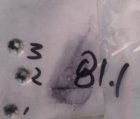Still not seeing "alot more" of anything?
Step down in contour, and you're near & close in weight. But if those extra ounces of pure steel still cause you to lose sleep, send the barrel off to someone legit (like Kampfeld) and have him flute the crap outta it for a around buck & a half. You'll still have a couple hundred in your pocket, and you should then be able to make it over that next hill, thanks to those precious ounces lost...
If it does boil down to aesthetics, then that seals the deal for me, as I happen to think carbon wraps look stupid. But then again, who am I to judge, since I've got rifles in nearly every color under the rainbow
Obvious that I'm being 'devils advocate' here, but I also AM a potential customer! Just haven't yet seen anything in the way of performance gain that a wrapped barrel earns, for twice (at least) the price?
P.S., for all the 'light rifle' guys...
There are some svelte, dandy stocks that won't accept anything more than a #4 contour. So, that pretty much precludes using one with a (fat) wrapped barrel, as even the 'light' sendero will overstuff the skinny barrel channel.
Food for thought!
Step down in contour, and you're near & close in weight. But if those extra ounces of pure steel still cause you to lose sleep, send the barrel off to someone legit (like Kampfeld) and have him flute the crap outta it for a around buck & a half. You'll still have a couple hundred in your pocket, and you should then be able to make it over that next hill, thanks to those precious ounces lost...
If it does boil down to aesthetics, then that seals the deal for me, as I happen to think carbon wraps look stupid. But then again, who am I to judge, since I've got rifles in nearly every color under the rainbow
Obvious that I'm being 'devils advocate' here, but I also AM a potential customer! Just haven't yet seen anything in the way of performance gain that a wrapped barrel earns, for twice (at least) the price?
P.S., for all the 'light rifle' guys...
There are some svelte, dandy stocks that won't accept anything more than a #4 contour. So, that pretty much precludes using one with a (fat) wrapped barrel, as even the 'light' sendero will overstuff the skinny barrel channel.
Food for thought!













